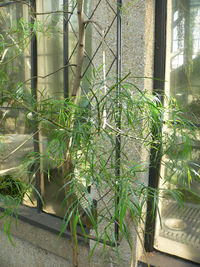Acacia leprosa
| Cinnamon wattle | |
|---|---|

| |
| An Acacia leprosa tree found at Longwood Gardens | |
| Scientific classification | |
| Kingdom: | Plantae |
| Clade: | Tracheophytes |
| Clade: | Angiosperms |
| Clade: | Eudicots |
| Clade: | Rosids |
| Order: | Fabales |
| Family: | Fabaceae |
| Subfamily: | Caesalpinioideae |
| Clade: | Mimosoid clade |
| Genus: | Acacia |
| Species: | A. leprosa
|
| Binomial name | |
| Acacia leprosa | |

| |
| Occurrence data from AVH | |
Acacia leprosa, also known as cinnamon wattle, is an acacia native to Australia. It occurs in woodland in Tasmania, New South Wales and Victoria. It occurs as a hardy shrub or small tree. The phyllodes (a modified flat leaf-like structure arising through an expanded petiole replacing the leaf blade) are 3–14 cm long and contain oil glands. The lemon-yellow flowers occur as globular heads in clusters in the leaf axils. The fruit is flat seed pod.
A number of varieties are currently recognised within the species including:[1]
- A. leprosa var. crassipoda Maslin & D.J.Murphy – type: Pyrenees Range, Victoria
- A. leprosa var. graveolens Maslin & D.J.Murphy – formerly known as Acacia verniciflua (southern variant), type: Gippsland Lakes
- A. leprosa Sieber ex DC. var. leprosa
- A. leprosa var. magna Maslin & D.J.Murphy – type: Cape Otway, Victoria
- A. leprosa var. uninervia Maslin & D.J.Murphy, formerly known as A. leprosa (large phyllode variant), type: near Healesville, Victoria
Former varieties include:
- A. leprosa var. binervis F.Muell., currently included in Acacia verniciflua
- A. leprosa var. tenuifolia Benth. also known as A. leprosa (Seymour variant), currently included in Acacia verniciflua
- A. leprosa (Dandenong Range variant), A. leprosa var. elongata Guilf. [nom. inval.] or A. leprosa var. Reclinata, currently known as Acacia stictophylla
The cultivar Acacia leprosa 'Scarlet Blaze' is the only Australian wattle to have red inflorescences (all the rest are yellow or cream-coloured, except for Acacia purpureapetala, which has purple flowers). It was discovered northeast of Melbourne in 1995, and released commercially in 2001. Acacia leprosa is mentioned in The Australasian Sketcher of Saturday 19 June 1880 in part two of an article on the Mallee Country,[2] as one of the "beautiful shrubs"[citation needed] found in the region and identified by Mr Guilfoyle, director of the Melbourne Botanic Gardens.[3]
Cultivation
[edit]The species prefers a well-drained sunny or lightly shaded situation. Propagation is by pretreated seeds or cuttings.[4]

References
[edit]- ^ "Acacia leprosa". Australian Plant Name Index (APNI), IBIS database. Centre for Plant Biodiversity Research, Australian Government, Canberra. Archived from the original on November 28, 2012. Retrieved 2010-08-14.
- ^ "The Mallee Country". The Australasian Sketcher with Pen and Pencil. Vol. VIII, no. 102. Victoria, Australia. 17 July 1880. p. 170. Retrieved 3 April 2024 – via National Library of Australia.
- ^ "Books". The Brisbane Courier. Vol. XXXIV, no. 3, 992. Queensland, Australia. 6 March 1880. p. 5. Retrieved 3 April 2024 – via National Library of Australia.
- ^ "Acacia leprosa". Australian Native Plants Society (Australia). Archived from the original on 3 March 2011. Retrieved 31 July 2011.
